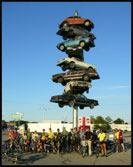In the Chicago suburb of Berwyn, Illinois, an iconic piece of public art featuring a 40-foot spear stabbing through a pileup of eight cars will soon be replaced with a Walgreens pharmacy.
In the Chicago suburb of Berwyn, Illinois, an iconic piece of public art featuring a 40-foot spear stabbing through a pileup of eight cars will soon be replaced with a Walgreens pharmacy.
The sculpture -- titled "The Spindle", but unofficially known as the "eight-car pileup" or the "car kabob" -- has towered over the parking lot of the Cermak Plaza Shopping Center since the cars were gored and hoisted in 1989. The piece has been neighbored by a number of retailers over the years. Its current backdrop is an outlet of the big box electronics retailer Circuit City and a huge store called Shoe Carnival, and by the end of the summer the site of the Spindle will become the 5,808th Walgreens Pharmacy in the United States.
The Spindle is most famous for its brief cameo role in an especially notable scene from the fine 1992 film "Wayne's World" (skip ahead to about 2:38 in the video), in which it serves as a poignant segway between the anthemic "Oh yeah/Oh yeah" section of Queen's "Bohemian Rhapsody" to the somber "Nothing really matters" finale.
The removal of the kabob has received coverage in the national press, which reports a sense of reluctance to remove the art as the city's mayor admits the unique "marketing power" of the sculpture. The city's website even features a photo of the Spindle in a section titled "Attractions and Visitor Info".
But the Spindle is not the only tourist draw in Cermak Plaza. The shopping center has also been the home to many other sculptures and public art works, as the plaza's owner happens to be a collector (the website Offbeat Travel has a more extensive history of the shopping center, its art, and its owner). The Oak Park (IL) Board of Realtors touts the plaza's artwork as a contributor to its success as a retail destination, but despite the sculpture's curiosity, it generates no tax revenue for the city. This is a shortcoming the new Walgreens Pharmacy will surely not suffer.
But will the Walgreens be able to replace the aesthetic value of the Spindle? Dustin Shuler, the artist who created the Spindle, thinks not. And judging by the plethora of retailers pictured in the Berwyn Development Corporation's panoramic photo survey of the area, another store is probably not a dire necessity.
Residents rallied for the sculpture's removal from the moment it was built, so the probability of massive public outcry over its replacement is low. Maybe it will be better for the city to not have a big metal spear next to its shopping center shooting through a bunch of old cars. Maybe the aesthetic value is zero in Berwyn, Illinois. Maybe this piece has served no purpose in its nearly 20-year lifetime. Maybe Walgreens is going to single-handedly revitalize the city and its proud people. I don't really know. But I do know that, in the end, this is a local decision, regardless of the sculpture's wider appeal and merit as a piece of public art in a world where creative expression is routinely trumped by the prospect of commerce. It might be easy for me, 2,000 miles away, to say that this public art deserves to be preserved (especially when the alternative is some cookie-cutter drug store), but when it comes down to it, the extra tax revenue generated by the drug store might just be a little more enticing. But only if you're lame.

Planetizen Federal Action Tracker
A weekly monitor of how Trump’s orders and actions are impacting planners and planning in America.

Chicago’s Ghost Rails
Just beneath the surface of the modern city lie the remnants of its expansive early 20th-century streetcar system.

Amtrak Cutting Jobs, Funding to High-Speed Rail
The agency plans to cut 10 percent of its workforce and has confirmed it will not fund new high-speed rail projects.

Ohio Forces Data Centers to Prepay for Power
Utilities are calling on states to hold data center operators responsible for new energy demands to prevent leaving consumers on the hook for their bills.

MARTA CEO Steps Down Amid Citizenship Concerns
MARTA’s board announced Thursday that its chief, who is from Canada, is resigning due to questions about his immigration status.

Silicon Valley ‘Bike Superhighway’ Awarded $14M State Grant
A Caltrans grant brings the 10-mile Central Bikeway project connecting Santa Clara and East San Jose closer to fruition.
Urban Design for Planners 1: Software Tools
This six-course series explores essential urban design concepts using open source software and equips planners with the tools they need to participate fully in the urban design process.
Planning for Universal Design
Learn the tools for implementing Universal Design in planning regulations.
Caltrans
City of Fort Worth
Mpact (founded as Rail~Volution)
City of Camden Redevelopment Agency
City of Astoria
City of Portland
City of Laramie





























